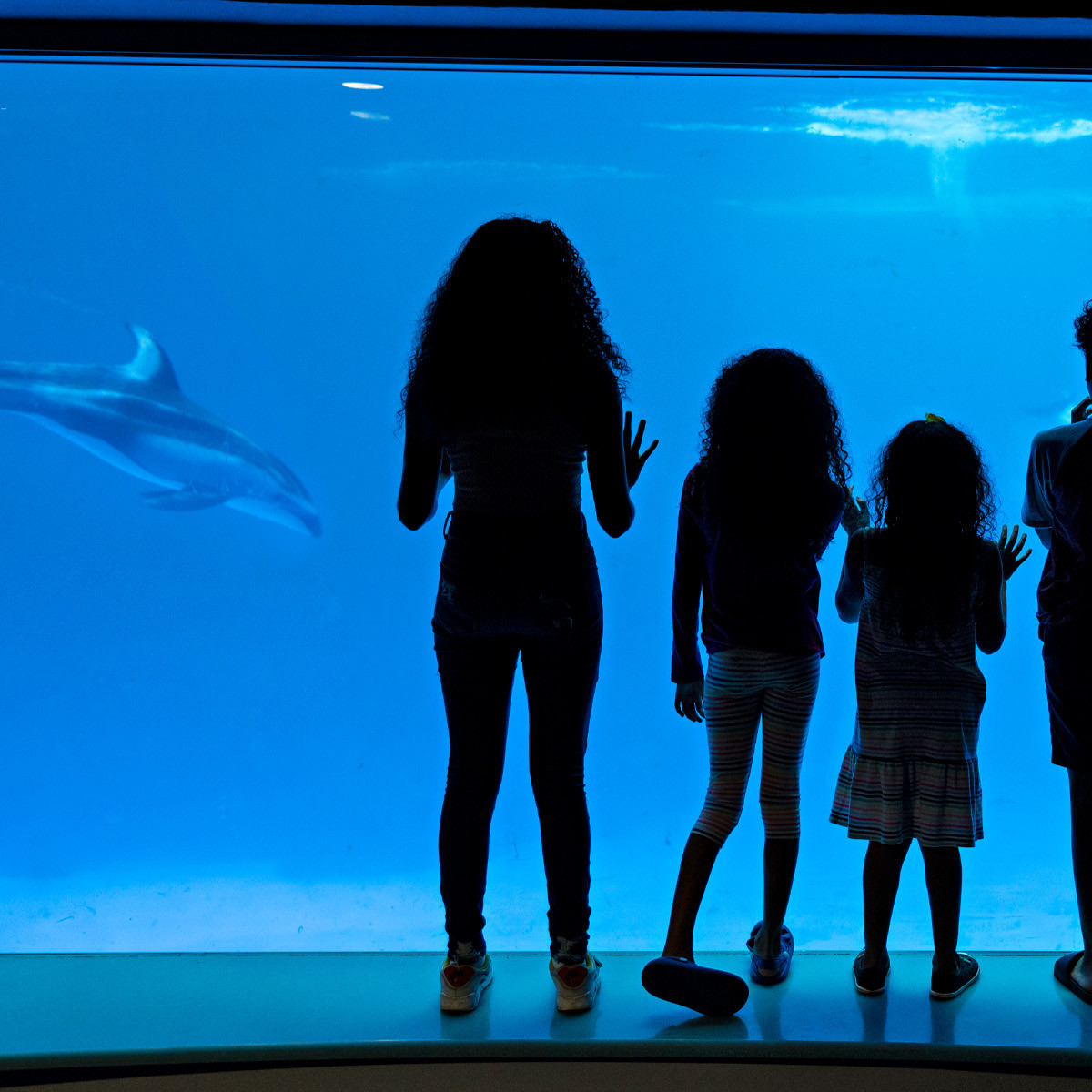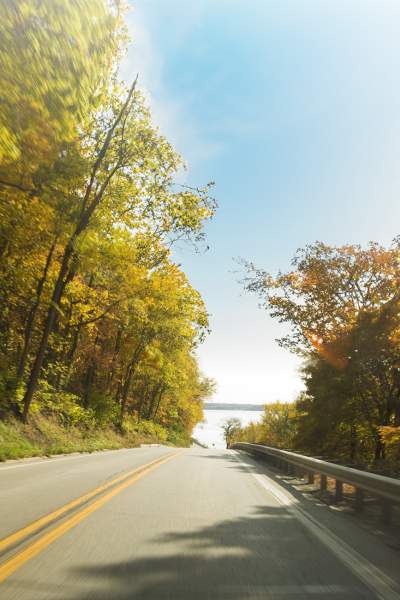Embark on an unforgettable journey along Illinois' seven scenic byways. From rolling hills to tranquil rivers, each route promises an adventure filled with natural wonders and historic charm.
Explore the iconic Great River Road, tracing the mighty Mississippi, cruise through Shawnee National Forest on the Ohio River Scenic Byway or enjoy the quaint charm of the Historic National Road.
Start planning your scenic escape today and discover the heart of the Midwest like never before.

1. Great River Road
EXPERIENCE THE MIGHTY MISSISSIPPI
Built along the Mighty Mississippi, at 550 miles long, the Great River Road runs almost the entire length of the state. With both northern and southern sections of the byway, this gorgeous river drive offers everything from outdoor adventure and quiet charm, to presidential and colonial history and some good old fashioned kitsch. There’s no better way to experience the life and industry of the Mississippi River.
Northwestern Region
Sink into European charm in Galena as you stroll through a story-book downtown. Chat to friendly locals at Miss Kitty’s Grape Escape, visit a local winery, hit the slopes for a day of skiing or book a night at the extravagant DeSoto House Hotel. And don’t miss a visit to Fulton to catch a glimpse of “De Immigrant,” one of only two working Dutch windmills in the country and the only in the state.
Quad Cities Region
If you want a closer look at the industry of the Mighty Mississippi, pull off in the Quad Cities area. In Moline, check out the John Deere Pavilion for a glimpse at the area’s agricultural heritage and a few Midwestern souvenirs, then check out a sightseeing boat tour on the Celebration Belle. For military buffs, visit the arsenal for its military museum and a bonus look at the lock and dam operations.
Heartland Region
History, historic sites and a little more history. The Heartland Region is where you’ll encounter the pioneer days of Joseph Smith, the remains of the ancient city of Cahokia and a host of preserved architecture. This is also where you’ll find the Meeting of the Great Rivers – another of the state’s scenic byways and one of the Seven Wonders of Illinois.
Southern Region
The Southern Region brings you to the end of the Great River Road and the start of the Ohio River Scenic Byway. French colonial architecture, early American and Civil War history and phenomenal outdoor adventures await along this stretch of the drive. Stop in Grand Tower for a trip to Devil’s Backbone—peculiar rock formations lining the Mississippi River.

2. Meeting of the Great Rivers Scenic Route
ONE OF THE SEVEN WONDERS OF ILLINOIS
Meeting of the Great Rivers is a breathtaking 33-mile section of the Great River Road, where the great Mississippi, Illinois and Missouri rivers come together. Extending from Pere Marquette State Park to the Lewis and Clark State Historic Site, traces of history can be seen all throughout the bluffs and river towns along the byway.
A Midwestern Treasure
The Meeting of the Great Rivers Scenic Byway is a Midwestern treasure with beautiful stretches of roadway cradled by the rolling waters of the Mighty Mississippi River and majestic limestone river bluffs. As you drive along the byway, you'ill find that the beauty of the region is a masterpiece of nature with whistling birds, colorful trees, unique plants and etched river bluffs.
Piasa Bird
There are more than 230 species of birds that can be seen around the Meeting of the Great Rivers. The bluffs are also a favorite haunt for migrating bald eagles—keep an eye out for the nation’s bird! A short drive up the byway in Alton is the famous Piasa Bird. This legendary man-eating dragon was painted on the bluffs along the Mississippi River by the Illini Indians.
Fast Eddie’s Bon Air
If you get hungry during your travels, head over for a bite at Fast Eddie’s Bon Air in Alton. This local favorite is the recipient of one of Enjoy Illinois’ coveted Delicious Destinations awards. Serving up tasty grub like the Big Elwood on a Stick at just the right price, this institution is the best place to grab a brew and relax after a long day’s drive.

3. Historic Route 66
THE MOTHER ROAD
The mother of all roads, and the original road trip, Route 66 begins in Chicago, Illinois. A mission all on its own, check out our Route 66 trip guide for even more juicy details about this offbeat stretch of American roadway. Classic Americana, roadside photo ops, history, dining and so much more awaits.
Chicago Adventures
Start your Route 66 journey in Chicago with iconic stops like the Cloud Gate, Navy Pier, and Lincoln Park Zoo. Don't miss your panoramic view of the city from the Willis Tower's Skydeck.
Joliet to Pontiac
Drive through Joliet with a stop at the historical Old Joliet Prison, then head to Wilmington to see the famous Gemini Giant. In Pontiac, explore the Illinois Route 66 Hall of Fame and Museum and snap a pic in front of the Route 66 mural.
Springfield
Visit the Abraham Lincoln Presidential Library and Museum in Springfield. Enjoy classic Route 66 attractions like the Cozy Dog Drive-In and the Route 66 Drive-In Theater, giving you a real taste of America.
Mississippi River Views
End your Route 66 journey in the Great Rivers and Routes region. Explore the Old Chain of Rocks Bridge, or relax in Grafton at Aerie's Resort for stunning sunset views over the Mississippi River.

4. Illinois River Road
STATE PARKS AND ROLLING HILLS
Travel the rolling hills of central Illinois as you follow the path of the Illinois River. At 291 miles, the Illinois River Road offers incredible views and opportunities to stretch your legs at some of the best state parks in Illinois. The Byway unites more than 100 nature-based destinations throughout the Illinois River Valley, beginning in Ottawa and ending 150 miles south in Havana. Find the best spots for hunting, fishing, hiking, biking, canoeing, wetlands, gardens, birding and watching wildlife.
Grandview Drive in Peoria
This 2.52-mile winding drive in Peoria was referred to by President Theodore Roosevelt as the “world’s most beautiful drive” during his visit in 1910. The drive features panoramic views of the Illinois River Valley, set against a backdrop of some of Illinois’ most remarkable homes.
Buffalo Rock State Park
Stretch your legs at Buffalo Rock State Park in Ottawa. This quaint park set into the bluffs of the Illinois River features five towering earthen sculptures molded from Illinois clay known as Effigy Tumuli. A great place to explore on your Illinois River adventure.
Starved Rock State Park
Featuring 13 miles of trails through 18 glacier-carved canyons, Starved Rock State Park is our must-visit stop. Whether you’re looking for a gentle stroll in Aurora Canyon or a more challenging hike on Lover’s Leap, this park is a stunner and must-see for its awe-inspiring beauty.

5. Lincoln Highway
DRIVING ACROSS THE HEARTLAND
Drive clear across northern Illinois on the nation’s first successful coast-to-coast highway. From the Indiana border, west toward the mighty Mississippi, you will find an adventure filled with variety, rich in history and heritage. Enjoy 179 miles of rolling farmland and classic Midwest traditions, as you loop around to the Great River Road or follow the byway toward Chicago.
South of Chicago
Enjoy the blend of suburban growth and rich architectural heritage as you travel south of Chicago. Take a historic jaunt through Frankfort where you'll encounter charming Victorian buildings and the restored Trolley Barn, before reaching Joliet, with its iconic Rialto Square Theatre and limestone-rich downtown.
Heading West
As you head west, your journey takes you through towns like Aurora, Batavia, Geneva, DeKalb, and Rochelle. Experience the convergence of major rail lines in Rochelle and explore DeKalb's vibrant atmosphere, complete with galleries, coffee bars, and the historic Egyptian Theatre.
Towards the Mississippi
This final stretch of the Lincoln Highway is a picturesque finale. Pass through towns central to two presidents' lives, before approaching the majestic Mississippi River through the scenic town of Fulton. Take in the breathtaking river views and enjoy Fulton's Dutch heritage.

6. Ohio River Scenic Byway
THE ROAD TO ADVENTURE
Take the scenic route to some of Illinois' best outdoor adventures as you wind your way along country roads and through the Shawnee National Forest on the Ohio River Scenic Byway. Travel the 188 miles around the southern tip of Illinois to experience some of the very best scenic views and outdoor destinations in the state.
Shawnee National Forest
The Shawnee National Forest is a Midwest destination that’s quite literally unlike any other. Towering rock formations and deep valleys carve the landscape around the river. Cave-in-Rock State Park and Garden of the Gods are popular natural attractions in the forest.
The Home of Superman
For some old-fashioned kitsch, visit the home of Superman in Metropolis. The town square is marked by a larger-than-life 15-ft. Superman, keeping watch over the small river town. You'll also find the world-famous Super Museum, home to 70,000+ items of Superman memorabilia.
Civil War History
Get a taste of the area’s colorful history at the Mound City Cemetery in the aptly named Mound City, where a presumed “Confederate Spy” is buried among the 2,700 Union and Confederate graves. The cemetery is one of the oldest national cemeteries in the country.

7. Historic National Road
FIRST OF ITS KIND
America’s first highway, the Historic National Road, stretches 164 miles from Marshall to East St. Louis. The Historic National Highway played a pivotal role in uniting the country and promoting interstate commerce. Visit prehistoric cities, Victorian architecture and Midwest small town America along the way.
Marshall to Casey
Begin your journey in Marshall, where you'll find the oldest house in Illinois, before heading to Casey. Casey offers a delightful spectacle with its collection of record-breaking giant items like knitting needles and a golf tee, giving you a whimsical taste of small-town America.
Greenup to Effingham
Travel through Greenup with its picturesque Jackson Truss covered bridge, through Teutopolis, and onward to Effingham. Effingham is home to a monumental 198-foot cross, the "Cross at the Crossroads," symbolizing hope to all who pass.
Vandalia to Collinsville
End your journey exploring Vandalia, Illinois' second capital and the place where Abraham Lincoln began his illustrious political career, and continue to Collinsville. Here, visit the prehistoric Cahokia Mounds, and see the world's largest catsup bottle. This blend of ancient history and playful roadside Americana encapsulates the joy of a classic road trip.

